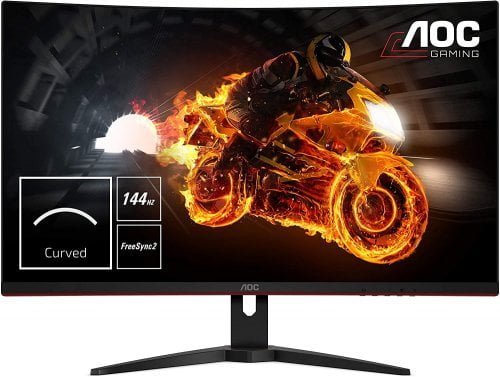Most of the people who buy a new computer monitor usually want to get the best display technology for their uses.
And when it comes to technology it doesn’t just mean the size or resolution of the screen, you should also think about the panel type you want to get.
What Is an IPS Monitor?
IPS is a panel technology used in LCDs (liquid-crystal displays), which includes most computer monitors and phones. The full form Of IPS is “in-plane switching.”
Today, you can see this IPS technology in most of the higher-end screens, but there are some inexpensive monitors also that have these IPS panels.
Usually, most photographers, artists, and graphic designers like these monitors because of various reasons and more importantly they give consonant colors at a wide range of viewing angles.
Most of the time you will see monitors comprising IPS panels referred to as simply “IPS monitors.” But it’s good to know more details about it if you are interested in getting one. After knowing all the details you can easily figure out if you need an IPS display for yourself or not.
The price of IPS monitors is usually high as compared to other panel technologies. You can see this difference more particularly when compared to TN monitors.
If you are interested in getting a new desktop IPS monitor, the average price range for a lower-end option is around $300, it can go low or high also depending upon size.
And if we talk about truly high-end IPS displays they can cost you thousands of dollars. The reason for their price may be because they have a greater resolution a larger color gamut and can display a wide range of colors.
And there are some other improvements also in image quality or features. This comprises things such as better uniformity, backlighting technology, built-in calibration tools, a larger screen size, and so on.
So, whether you should get an IPS monitor or not all depends upon the work that you do. If you are in the field of visual art, you can say it is necessary.
If you are a photographer, then IPS is the only panel technology that will help you the most in your field.
If you want to get accurate colors that show, as much as possible, how your image looks then this is the best.
And if your budget is not allowing you to buy, don’t worry you don’t have to go for the most exclusive IPS panels, either. You can go for the lower-end options also as they are also quite good, definitely with good colors than similarly priced TN displays.
But, if you’re in a work that doesn’t require maximum color accuracy, an IPS monitor may be needless. And there are some applications; for which you may rather prefer a TN monitor, as it has its advantages.

Benefits of IPS Monitor:
The main reason people prefer IPS monitors is their color. If you are worried about color accuracy – and want everything not just coming close to getting things reasonable, but absolute color precision as much as possible, then most certainly IPS is the way to go. Let’s put some light on its benefits.
Enhanced Viewing Angles:
You can say that the biggest benefit of IPS monitors is that they look in tune at a much broader range of viewing angles. And when we look at TN panels they are not that good in this respect.
The colors will begin to change and sometimes even transpose completely if you look at the monitor from the top, bottom, or sides.
The brightness of the screen also changes even if you move a little bit. This becomes very awkward when you’re looking at the image and how it is meant to be seen, and this leads to inconsistencies particularly if you’re working with photos or other digital art.
IPS monitors are also not that perfect in this respect –sometimes they also change when viewed from the sides, but they’re much better.
Because IPS panels need far more extreme angles to shift colors fiercely; normally standard IPS monitors provide you with about 178 degrees of viewing freedom in every direction.
Additional Accurate Color:
One more advantage that IPS monitors have over other options on the market: is that they can reproduce 8-bit color (256 shades of each primary color), without mixing 6-bit colors (64 shades per primary color) for the same effect, as TN monitors usually do.
To put it in simple words you can say, they can achieve 8-bit color, or sometimes more, without dithering.
The meaning of dithering is your display places more than one “almost correct” pixel almost next to one another to give the vision of the correct color.
But the question over here is, whether we’re capable of seeing the differences or not. And this will mainly depend upon the specific monitors in question,
In some cases, it certainly can be visible, especially in gradients of color. 8-bit monitors usually look much smoother.
But don’t forget that this differs on a screen-by-screen basis, so you can get some 8-bit IPS monitors also that have bad color gradients.
Larger Color Gamut:
If you are interested in displaying a bigger subset of colors (gamut), then definitely IPS is the way to go.
But no monitor on the market can display the entire gamut of colors humans can see, better IPS panels can get you closer than TN.
Usually, you see this information when you see a monitor advertising “100% of sRGB color space” or “98% of AdobeRGB colors space”.
In this way, they refer to the subset of colors that they can display. It’s better to go for a larger gamut since it expands the range of colors it can display accurately from your photos.
Better Contrast Ratio:
There are different screen manufacturers and many screen manufacturers advertise their “contrast ratio” for a specific display – something like 1:1000.
You can’t compare these numbers across brands, and they hardly matter when you’re purchasing a monitor. But, you can’t say that the concept of contrast ratio is pointless.
Monitors comprising finer contrast ratios allow you to find more details in the dark region of the display, with more tonality in the shadows.

When it comes to photography and graphic designing this is a big deal, where mostly you deal with ultra-fine differences in dark regions of the image.
When we talk about contrast ratios IPS monitors are usually better as compared to TN panels. But some newer TN panels are trying to catch up.
But still, IPS is the way to go. And there is one more type of display, VA monitors, these mostly comprise the best contrast ratios of all, but they aren’t that good when it comes to color accuracy, so photographers prefer to stick with IPS instead.
Conclusion:
Hope we have covered everything above to give you a good understanding of IPS monitors and whether you need this for your work or not.
As we have discussed above if you are into photography, designing, and other works that value maximum color accuracy then you can go for an IPS monitor.
And If you are the one who hardly cares about color accuracy and isn’t as important to you, and you don’t want to spend much on a monitor then TN is the better option for you.
